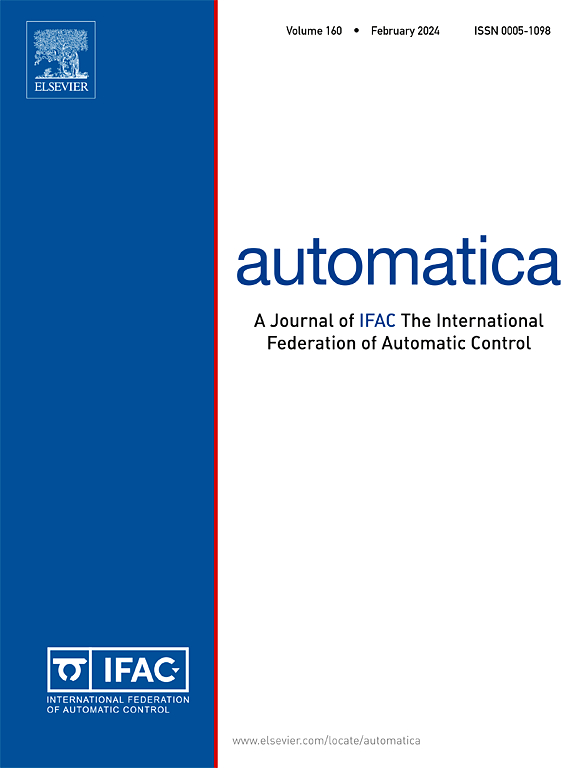Global exponential stabilization of 2 × 2 linear hyperbolic PDEs via dynamic event-triggered backstepping control
IF 5.9
2区 计算机科学
Q1 AUTOMATION & CONTROL SYSTEMS
引用次数: 0
Abstract
This paper introduces novel dynamic event-triggered control (ETC) mechanisms for 2 × 2 linear hyperbolic PDEs in three configurations: continuous-time event-triggered control (CETC), periodic event-triggered control (PETC), and self-triggered control (STC). These mechanisms ensure global exponential stability (GES) under ETC using PDE backstepping, with stability estimates provided in the spatial norm of the states. The proposed CETC and PETC designs are observer-based and require continuous boundary measurements collocated with the actuation. In contrast, the STC design requires full-state measurements; however, unlike CETC and PETC, it does not require continuous measurements for the triggering mechanism—only measurements taken at event times. In the CETC design, a lower bound on the time between two consecutive events is enforced, and a dynamic variable with appropriately designed switching dynamics is introduced. By employing a novel Lyapunov functional, GES of the closed-loop system is established under zero-order hold implementation of the backstepping control between events. Events are triggered when the dynamic variable crosses zero from the positive side, after which it is immediately reset to an appropriate nonnegative value. Detecting events, therefore, necessitates continuous monitoring of this dynamic variable. To address this limitation, PETC and STC strategies are proposed. The PETC design identifies a suitable triggering condition that requires only periodic checks and derives an upper bound on the allowable sampling period. This PETC approach preserves the GES guaranteed by CETC without requiring continuous monitoring of a triggering condition, although it still relies on continuous measurements. Unlike CETC and PETC, STC requires neither continuous measurements nor monitoring of a triggering condition. Instead, at each event, STC computes the time to the next event — beyond a suitably enforced minimal dwell-time — using only measurements taken at events. Despite relying solely on event-triggered measurements, STC is capable of guaranteeing GES of the closed-loop system. The well-posedness of the closed-loop systems under all three strategies is established. A simulation study is provided to illustrate the theoretical results.
基于动态事件触发反步控制的2 × 2线性双曲偏微分方程全局指数镇定
本文介绍了2 × 2线性双曲偏微分方程在连续时间事件触发控制(CETC)、周期事件触发控制(PETC)和自触发控制(STC)三种构型下的动态事件触发控制(ETC)机制。这些机制使用PDE反演确保ETC下的全局指数稳定性(GES),并在状态的空间L2范数中提供稳定性估计。所提出的CETC和PETC设计是基于观测器的,并且需要连续的边界测量与驱动相匹配。相比之下,STC设计需要全状态测量;然而,与CETC和PETC不同的是,它不需要对触发机制进行连续测量,只需要在事件发生时进行测量。在CETC设计中,对两个连续事件之间的时间设定了一个下界,并引入了一个动态变量,该变量具有适当设计的切换动力学。利用一种新颖的Lyapunov泛函,在零阶保持实现事件间回溯控制的情况下,建立了闭环系统的GES。当动态变量从正方向越过零时触发事件,之后立即将其重置为适当的非负值。因此,检测事件需要持续监视这个动态变量。为了解决这一限制,提出了PETC和STC策略。PETC设计确定了一个合适的触发条件,只需要定期检查,并推导出允许采样周期的上限。这种PETC方法保留了CETC保证的GES,而不需要连续监测触发条件,尽管它仍然依赖于连续测量。与CETC和PETC不同,STC既不需要连续测量,也不需要监测触发条件。相反,在每个事件中,STC只使用在事件中进行的测量来计算到下一个事件的时间(超出适当强制的最小驻留时间)。尽管仅仅依赖于事件触发的测量,但STC能够保证闭环系统的GES。建立了三种策略下闭环系统的适定性。通过仿真研究验证了理论结果。
本文章由计算机程序翻译,如有差异,请以英文原文为准。
求助全文
约1分钟内获得全文
求助全文
来源期刊

Automatica
工程技术-工程:电子与电气
CiteScore
10.70
自引率
7.80%
发文量
617
审稿时长
5 months
期刊介绍:
Automatica is a leading archival publication in the field of systems and control. The field encompasses today a broad set of areas and topics, and is thriving not only within itself but also in terms of its impact on other fields, such as communications, computers, biology, energy and economics. Since its inception in 1963, Automatica has kept abreast with the evolution of the field over the years, and has emerged as a leading publication driving the trends in the field.
After being founded in 1963, Automatica became a journal of the International Federation of Automatic Control (IFAC) in 1969. It features a characteristic blend of theoretical and applied papers of archival, lasting value, reporting cutting edge research results by authors across the globe. It features articles in distinct categories, including regular, brief and survey papers, technical communiqués, correspondence items, as well as reviews on published books of interest to the readership. It occasionally publishes special issues on emerging new topics or established mature topics of interest to a broad audience.
Automatica solicits original high-quality contributions in all the categories listed above, and in all areas of systems and control interpreted in a broad sense and evolving constantly. They may be submitted directly to a subject editor or to the Editor-in-Chief if not sure about the subject area. Editorial procedures in place assure careful, fair, and prompt handling of all submitted articles. Accepted papers appear in the journal in the shortest time feasible given production time constraints.
 求助内容:
求助内容: 应助结果提醒方式:
应助结果提醒方式:


